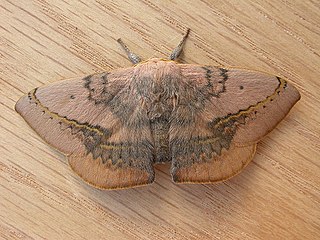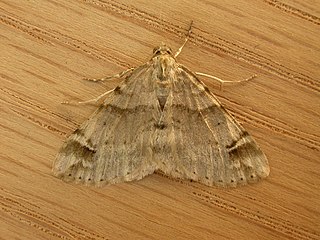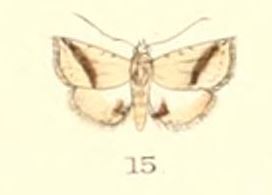
The Elachistidae are a family of small moths in the superfamily Gelechioidea. Some authors lump about 3,300 species in eight subfamilies here, but this arrangement almost certainly results in a massively paraphyletic and completely unnatural assemblage, united merely by symplesiomorphies retained from the first gelechioid moths.

Epermeniidae or the fringe-tufted moths is a family of insects in the lepidopteran order with about 14 genera. Previously they have been divided in two subfamilies Epermeniinae and Ochromolopinae but this is no longer maintained since the last group is probably hierarchically nested within the first. They are presently placed in their own superfamily but have previously been placed among the Yponomeutoidea or Copromorphoidea with which they share some features. Their systematic placement among the apoditrysian group "Obtectomera" is however uncertain. They show some morphological similarities to the "plume moths", for example the wing fringe has similar groups of scales. There are also some similarities to Schreckensteinioidea, for example spiny legs and at least in some species an open-network cocoon. The genus Thambotricha from New Zealand may be the sister group of all other extant members. The most important genera are Epermenia, Ochromolopis and Gnathifera. The group has been extensively revised and catalogued by Dr Reinhard Gaedike.
The Tineodidae or false plume moths are a family of moths with in some cases unusually modified wings: Like in some related moths, the wings of several Tineodidae are decomposed into several rigid spines. This is a small family, with about a global total of 20 species described to date; some undescribed species are known or suspected to exist however. They seem to be of Australian origin, where they are most diverse, but range through the Wallacea to Southeast and South Asia, and into the Pacific to the Marquesas Islands.

The Momphidae, or mompha moths, is a family of moths with some 115 described species. It was described by Gottlieb August Wilhelm Herrich-Schäffer in 1857. These moths tend to be rather small with a wingspan of up to 21 mm. The wings are held folded over the body at rest. The larvae are concealed feeders, either as leaf miners or within seeds or stems.

The Pyralinae are the typical subfamily of snout moths and occur essentially worldwide, in some cases aided by involuntary introduction by humans. They are rather rare in the Americas however, and their diversity in the Australian region is also limited. Altogether, this subfamily includes about 900 described species, but new ones continue to be discovered. Like many of their relatives in the superfamily Pyraloidea, the caterpillar larvae of many Pyralinae – and in some cases even the adults – have evolved the ability to use unusual foods for nutrition; a few of these can become harmful to humans as pests of stored goods.

Anarsia is a genus of moths in the family Gelechiidae.

Anthela varia, the variable anthelid, is a moth of the family Anthelidae. The species was first described by Francis Walker in 1855. It is found in the coastal areas of southern Western Australia, southern Queensland, New South Wales, and Victoria.

Syneora hemeropa, the ring-tipped bark moth, is a moth of the family Geometridae first described by Edward Meyrick in 1892. It occurs in eastern Australia from Queensland down to Tasmania.

Anthela nicothoe, the urticating anthelid, is a moth of the family Anthelidae.

Palpita is a genus of moths of the family Crambidae. Members of the moth genus Stemorrhages may be very similar in appearance.

Archips is a genus of tortrix moths the tribe Archipini. Species include the oak leaf roller, which eats the leaves of oak trees.
Poecilasthena euphylla is a moth of the family Geometridae first described by Edward Meyrick in 1891. It is found in Australia, including Tasmania.
Rivula niphodesma is a moth of the family Erebidae first described by Edward Meyrick in 1891. It is found in Australia in the Northern Territory and Queensland and Buru.

Synemon is a genus of moths within the family Castniidae. It was described by Edward Doubleday in 1846. The genus contains 24 described and 20 undescribed species. These species are found across mainland Australia and on Kangaroo Island, with the highest diversity in Western Australia. Synemon species can be found in a range of habitats, including woodlands, heathlands and native perennial grasslands. The adults fly during the daytime in warm to hot weather. They have clubbed antennae, and are often mistaken for butterflies.

Anthela is a genus of moths of the family Anthelidae. The genus was erected by Francis Walker in 1855.
Mesoptila compsodes is a moth in the family Geometridae first described by Edward Meyrick in 1891. It is found in Australia. Mesoptila compsodes is the type species of the genus Mesoptila.
Rhobonda heliaspis is a moth in the family Choreutidae. It was described by Edward Meyrick in 1926. It is found in Bolivia.

Procometis is a genus of moths in the family Autostichidae.

Eublemma pudica is a moth of the family Erebidae first described by Snellen in 1880. It is found in Sri Lanka, India, Fiji and Australia.















